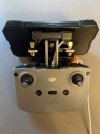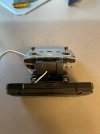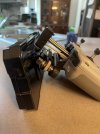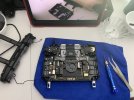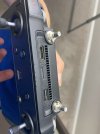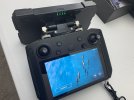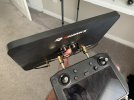Edited Distances:
I'm not one to obey VLOS as an absolute, every second of every flight, so you BVLOS haters need not comment. Anyway, I attached the Alientech Amplified DUO antenna to my Mavic 3's standard remote. I did a distance test before and after the install in a relatively populated suburban environment without hills on an almost windless day.
Results were impressive. The test was done in Sport mode with a constant speed between 46 and 47 mph. The stock remote with Yagi antennas attached gave me 5 miles distance before complete signal loss and a RTH was auto initiated. At 4 miles the Yagi antennas started showing video corruption and video latency or lag. The Alientech Amplified DUO gave me 7 miles distance due to low battery, not signal interference. I was only able to go 7 miles because I was flying in sport mode and the battery hit 50%, so I turned around. I still had a full set of white reception bars when I turned around. If I had followed the recommended 15 MPH speed, perhaps I would have had more battery life to go further, but I wanted to test the battery life at top speed as well and spend as little time in the air BVLOS as possible. Also, of note, I was able to fly at a lower level for a longer distance with the Alientech mod due to the stronger signal. Not one time did the video become corrupted or suffer latency with the Alientech Amplifier.
I've tested the Alientech Amplified DUO with the Air2s, EVO2, M2P, and now the M3. The alientech duo was most effective with the M3's remote. The new Occusync system, and extra internal drone antennas, combined with the amplified Alientech antenna gives the user the best signal with the least latency and or video feed corruption, and not just at long distances. At short distances within VLOS, with obstacle and signal interference, the Amplified Alientech Duo performed flawlessly. But of course, large Buildings caused significant interference, but not nearly as much with the use of the Alientech mod.
I posted this test, so those of you considering increasing remote reception and signal stability, won't have to do it. This was my only test, and last range test assessing Alientech's Amplified Duo antenna for the Mavic 3 standard remote.
I have read that the Mavic 3's Pro Remotes have removable SMA antennas. I believe they are SMA antennas? Is this correct? By placing the correct adaptors on the Mav 3 Pro remote, putting an Amplified Alientech DUO on the pro remote would be easy. But, adding another 450 dollars on top of it's already steep price would be difficult to justify.
I'm not one to obey VLOS as an absolute, every second of every flight, so you BVLOS haters need not comment. Anyway, I attached the Alientech Amplified DUO antenna to my Mavic 3's standard remote. I did a distance test before and after the install in a relatively populated suburban environment without hills on an almost windless day.
Results were impressive. The test was done in Sport mode with a constant speed between 46 and 47 mph. The stock remote with Yagi antennas attached gave me 5 miles distance before complete signal loss and a RTH was auto initiated. At 4 miles the Yagi antennas started showing video corruption and video latency or lag. The Alientech Amplified DUO gave me 7 miles distance due to low battery, not signal interference. I was only able to go 7 miles because I was flying in sport mode and the battery hit 50%, so I turned around. I still had a full set of white reception bars when I turned around. If I had followed the recommended 15 MPH speed, perhaps I would have had more battery life to go further, but I wanted to test the battery life at top speed as well and spend as little time in the air BVLOS as possible. Also, of note, I was able to fly at a lower level for a longer distance with the Alientech mod due to the stronger signal. Not one time did the video become corrupted or suffer latency with the Alientech Amplifier.
I've tested the Alientech Amplified DUO with the Air2s, EVO2, M2P, and now the M3. The alientech duo was most effective with the M3's remote. The new Occusync system, and extra internal drone antennas, combined with the amplified Alientech antenna gives the user the best signal with the least latency and or video feed corruption, and not just at long distances. At short distances within VLOS, with obstacle and signal interference, the Amplified Alientech Duo performed flawlessly. But of course, large Buildings caused significant interference, but not nearly as much with the use of the Alientech mod.
I posted this test, so those of you considering increasing remote reception and signal stability, won't have to do it. This was my only test, and last range test assessing Alientech's Amplified Duo antenna for the Mavic 3 standard remote.
I have read that the Mavic 3's Pro Remotes have removable SMA antennas. I believe they are SMA antennas? Is this correct? By placing the correct adaptors on the Mav 3 Pro remote, putting an Amplified Alientech DUO on the pro remote would be easy. But, adding another 450 dollars on top of it's already steep price would be difficult to justify.
Last edited:






